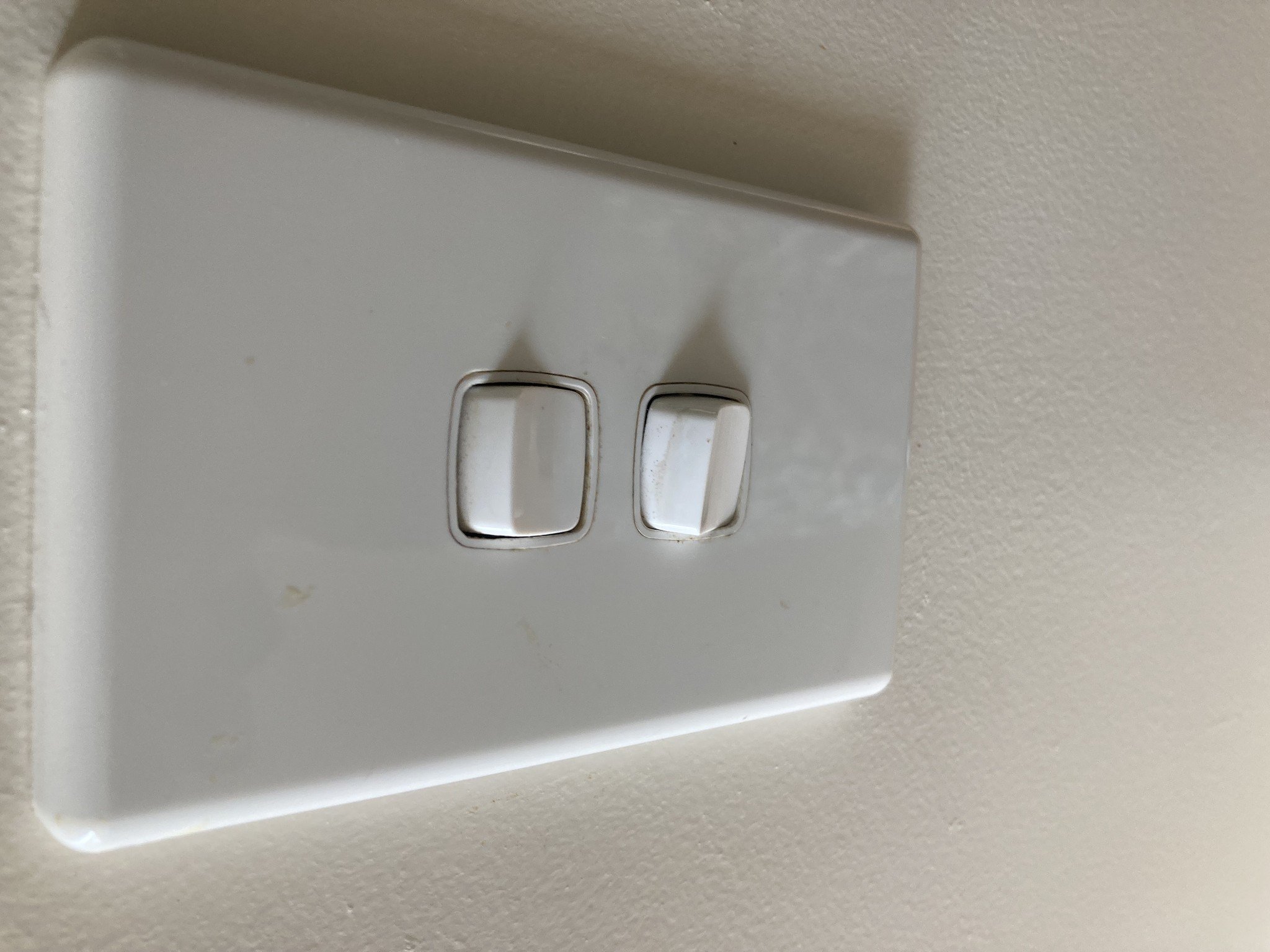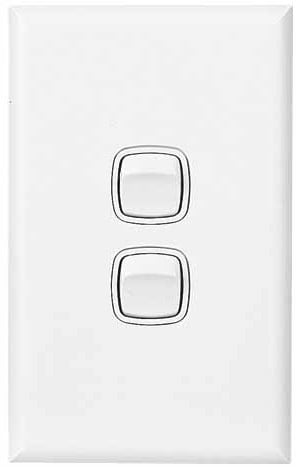Recently, a light switch in my kitchen, while it is still working, sits out per the image below. I noticed today, the oven wall switch is similar. What is happening.
|
|
|
Keep calm, and carry on posting.
Referral Links: Sharesies - Backblaze -
Are you happy with what you get from Geekzone? If so, please consider supporting us by subscribing.
No matter where you go, there you are.
can this be done as a DIY. I can replace a power point switch without issue.
OllieF:
can this be done as a DIY. I can replace a power point switch without issue.
legally yes. but if you have to ask you probably don't have the skills to do it. sorry. mains is a little unforgiving and i have seen fires from pro's getting it wrong.
yeah ok fair enough. The broken switch is a double switch that turns on the same lights as a switch on the other side of the kitchen. They were installed in 2010. With the powerpoints, the plastic started failing around the same time a few years ago. It was expensive to get electrician to do, and someone showed us how to do it, and since we have more or less replaced the whole house.
I wonder if all the switches are now failing which is why I would be keen........but never done a light switch before and not worth undue risk.
OllieF:
Recently, a light switch in my kitchen, while it is still working, sits out per the image below. I noticed today, the oven wall switch is similar. What is happening.
With switches I have seen, the switch itself is held in place behind the plate by two friction-fit mounts on each side of the switch hole - push the switch back to remove, push forward (until it clicks) to install to the plate. From the picture it looks like one side has been pushed back. If the mount on that side is broken then the plate (but not the switch) will need to be replaced. If the mount is intact, just push the switch forward to correctly re-install.
Make sure you have isolated the switch first before attempting anything.
--
OldGeek.
Voyager referral code: https://refer.voyager.nz/
its a very easy job to replace, usually 3 wires.
1. turn off power
2. take it off
3. take photo
4. go to bunnings and buy a replacement
5. replace it
you should know at step 3 if its too complicated for you, but its usually a single screw driver job.
not quite that simple.
can be tricky if they are using loop connector, sometimes they don't have that connector.
common mistakes is laving a strand hanging out. not tightening it enough and not have it grip the wire well enough (which causes overheating and fires) or if there is a few cables in the connector, getting them twisted back together so they fit. the replacement may have the terminals in a different location, but they should be marked.
tweake:
not quite that simple.
can be tricky if they are using loop connector, sometimes they don't have that connector.
common mistakes is laving a strand hanging out. not tightening it enough and not have it grip the wire well enough (which causes overheating and fires) or if there is a few cables in the connector, getting them twisted back together so they fit. the replacement may have the terminals in a different location, but they should be marked.
Some of the cheaper fittings also can break or screws / fittings strip when you tighten the screws too much. I find PDL 600 series to be good and reliable with a wide range of components you need.
Pretty sure those are PDL 600 switches. Bunnings, M10 etc don't usually have them, so will need to get from one of the wholesalers like Ideal.
As above, you can legally replace the switch, but don't do it if you have any doubts.
reven:
its a very easy job to replace, usually 3 wires. Between 2 and 6 wires.
1. turn off power AT THE MAIN SWITCH BOARD
1a. Confirm there is no power at the appliance.
2. take it off
3. take photo
4. go to bunnings and buy a replacement
5. replace it
6. AFTER TURNING POWER ON, CONFIRM THE CASE OF THE APPLIANCE IS NOT LIVE.
you should know at step 3 if its too complicated for you, but its usually a single screw driver job.
Suggested Edits in Bold
Confirm power really is off before sticking your fingers in there!
Oven switches have a higher current rating than light switches (circa 32 amps vs 10-15 amps). If you install a light switch on the oven, it will melt when you turn on >3 elements.
Modern oven switches typically have a different terminal configuration to light switches. (Single throw switch vs double throw). Also if you change model/brand/era, the terminal configuration can change, rendering your photo redundant. My old man can rewire a light switch but got confused when re-doing the oven switch and I had to sort it out for him.
Make sure terminals on the oven switch are done right. Tight with no broken or missed copper stands etc. Ovens run much closer to the current limit of the switches and wiring than most lights, so they aren't as forgiving as light switches and are more prone to over heating if your connections aren't 100%.
tweake:
not quite that simple.
can be tricky if they are using loop connector, sometimes they don't have that connector.
common mistakes is laving a strand hanging out. not tightening it enough and not have it grip the wire well enough (which causes overheating and fires) or if there is a few cables in the connector, getting them twisted back together so they fit. the replacement may have the terminals in a different location, but they should be marked.
Another rookie mistake is to tighten the screws down onto the insulation itself as opposed to just the bare end only.
Whilst the difficult we can do immediately, the impossible takes a bit longer. However, miracles you will have to wait for.
tripper1000:
Oven switches have a higher current rating than light switches (circa 32 amps vs 10-15 amps). If you install a light switch on the oven, it will melt when you turn on >3 elements.
Modern oven switches typically have a different terminal configuration to light switches. (Single throw switch vs double throw). Also if you change model/brand/era, the terminal configuration can change, rendering your photo redundant. My old man can rewire a light switch but got confused when re-doing the oven switch and I had to sort it out for him.
Make sure terminals on the oven switch are done right. Tight with no broken or missed copper stands etc. Ovens run much closer to the current limit of the switches and wiring than most lights, so they aren't as forgiving as light switches and are more prone to over heating if your connections aren't 100%.
really good point. some oven switches look exactly like light switches. same size etc, but higher rating. very easy to get mixed up.
i replaced my stove one years ago and deliberately fitted a completely different looking one, partly for that reason (i didn't like such a small switch).
So far after reading the responses, I removed the light switch cover plate, turned off the power and unscrewed the main plate from the wall. Its very different to a powerpoint - (I was hoping for red wire to red colcur hole etc). Not so, I will hope that these two are isolated and it doesnt start happening all over the house, and just get an electrician in.
A HPM Excel Double switch from M10 would suit the one in the photo I would think:
As per others if in doubt get an Electrician. Make sure power is off - and not just the light switch circuit but the main switch breaker. Some older houses have a few surprises such as shared neutral or incorrect wiring and a cable might be still live when your not expecting it.
OllieF:
So far after reading the responses, I removed the light switch cover plate, turned off the power and unscrewed the main plate from the wall. Its very different to a powerpoint - (I was hoping for red wire to red colcur hole etc). Not so, I will hope that these two are isolated and it doesnt start happening all over the house, and just get an electrician in.
While you can lookup the wiring colour code I think this is the best plan.
|
|
|
